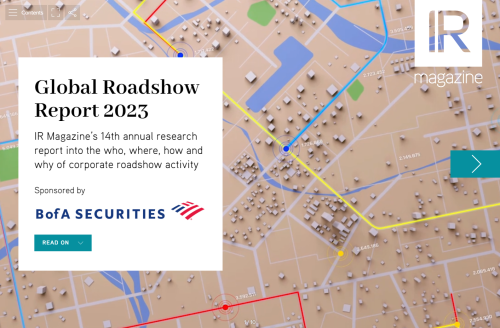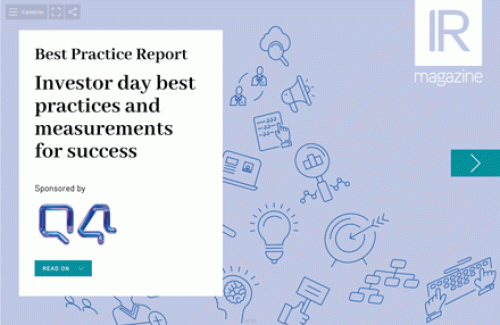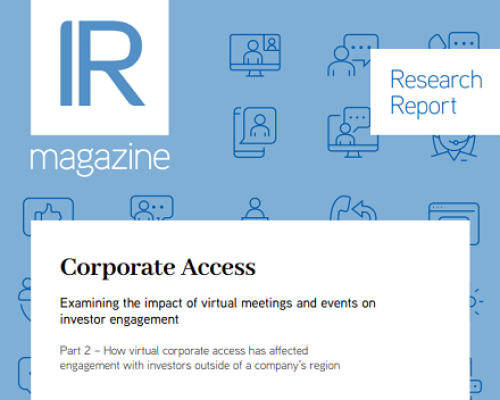Companies are taking control over the process from brokers, but there is a danger of relying too much on filings data
It’s that time of year again. January heralds the period when many IR departments sit down to plan their roadshow schedule for the next six to 12 months. Indeed, research undertaken by XbInsight, IR magazine’s research arm, finds the highest proportion of respondents to its global roadshow survey begin planning in January.
Here, we gather seven tips from roadshow advisers and other market specialists to help you get through another year.
1. Take control
There are many dangers in giving too much rope to the sell side, with pointless meetings – as far as IROs are concerned – being the main gripe. Leaving the logistics to your broker is also a risk. There is nothing more formative for a young IRO than being left waiting on the curb for a late hire car, with nobody but an increasingly agitated member of senior management for company.
More seriously, many companies rely on the sell side to get them out to investors, and greatly appreciate the variety of help on offer. But the growing number of sell-side companies is putting firms in a strong bargaining position. Some now carry roadshow checklists with various demands, such as feedback from the accounts visited. If the broker can’t guarantee what’s being requested, it doesn’t get the gig.
‘The one big trend we have noticed over the last year or so is that clients are taking more ownership of the roadshow process,’ observes Bill Haney, global head of investor relations services at Thomson Reuters. ‘Companies are still relying a lot on brokers, and they still value the broker’s input, but they are also putting a lot more of their own names and ideas into the process to make sure they are really using senior management time effectively.’
2. Don’t rely solely on data
Having said that IR departments should take more control over the planning process, it’s also worth noting that the information you pull from your data provider will only tell you part of the story. In the US, 13Fs are useful snapshots of activity, but they are also pretty much out of date by the time anyone gets to read them. What’s more, some institutions – for example, many European pension funds – do not file at all.
‘There are many big UK institutions that are like supermarkets: they manage a bit of everything. They have mutual funds, pension funds, insurance money, the whole gamut,’ says Adrian Rusling of Phoenix IR, which organizes roadshows for large-cap companies around Europe. ‘They might be filing the mutual fund positions, but they might not be filing everything. The disclosure is mixed.’
Another section of the market often not covered by regulatory filings is the private banking sector, adds Rusling, who points to Swiss institutions in particular. ‘Companies may think they don’t have much ownership in Switzerland,’ he says. ‘But if you are a blue chip, chances are you have pretty good ownership in that country, as it likes to invest in things it knows and understands.’
3. Be prepared for shorter confirmation notice
Faced with a growing number of requests for meetings, the investment community is waiting for longer before setting a date and time for a meeting. ‘A lot of the time, if we have a roadshow in New York, the schedule doesn’t fill up until the week beforehand,’ explains Charles Moreau, co-manager of corporate access at WJB Capital Group. ‘It depends on the city, of course. In regional markets there seems to be a longer period where people are willing to commit to a meeting. It’s probably a sign of the number of events coming through town.’
4. Watch out for bottlenecks
People on all sides of the market – buy side, sell side and issuers – report a growing number of roadshows and conferences. This means that, at certain points in the year, bottlenecks are forming when it is becoming increasingly difficult to get things done.
The three weeks before the last Thanksgiving celebration in the US were said to be particularly busy. This period – which falls after many results announcements and before the beginning of the Christmas holidays – saw a phenomenal amount of activity in 2010. We can expect the same in 2011.
Overall, the number of events is on the increase, says Greg Parks, editor of the Seminar Schedule, a calendar of investor conferences sent out twice a month by the Wall Street Calendar. He denies, however, that companies are becoming ‘conferenced-out’ by the demand.
‘Brokerage firms have been moving in the direction of providing more management access for institutional clients,’ says Parks in an email. ‘I have not been aware of people complaining of too many such conferences. And if audiences were too thin, that would be something to complain about.’
5. Spread yourself around
To cope with the increased sell-side demand for management time, companies in North America are changing their approach to the roadshow schedule. Instead of putting on three or four longer roadshows each year, issuers are now doing several shorter trips, where each one might last only one or two days.
This fact was borne out by the results of BNY Mellon’s sixth annual survey of investor relations practices. It finds that North American respondents hold, on average, 7.1 non-deal roadshows a year in their home market. By holding a larger number of shorter roadshows, companies can more easily spread themselves out among the sell-side firms that follow them.
6. Plan early
No two companies have the same investor relations set-up, and they also all have different approaches to planning their roadshow itineraries. But it is useful to note that most companies tend to plan the roadshow schedule a year in advance.
‘Annual planning is how the vast majority of our clients approach this,’ says Haney. ‘When we go and visit clients, a lot of them have what we call ‘the big board’ on one side of the office, which is a calendar that covers the whole year. It often revolves around their fiscal period. They’ll wait till the fiscal results are over, let the dust settle, and then work out the next four quarters.’
7. Record your progress
Another piece of advice is to learn from what has come before. A surprising number of companies do not, says Rusling. ‘There is a longer-term, strategic angle that companies need to think about,’ he explains. ‘Companies should ask themselves: over the last three or five years, what have we achieved? A certain number of companies will use a different sell-side firm every time, and if you ask them what they have done over the last three years, they don’t know.’
Rusling offers some examples of the kinds of questions companies might think about in relation to their roadshow activities:
- How many institutions do you see a year?
- What proportion of your shareholder base do you tend to see?
- What proportion of your potential base do you see?
- What proportion of the top 100 institutions in Europe have you seen in the last 12 months?
‘One way an IRO can evaluate what he or she has been doing is by demonstrating to senior management the scope of what he or she has achieved over a given period in time,’ concludes Rusling.










